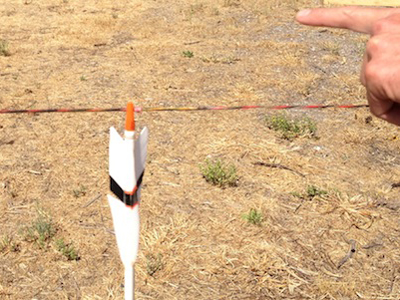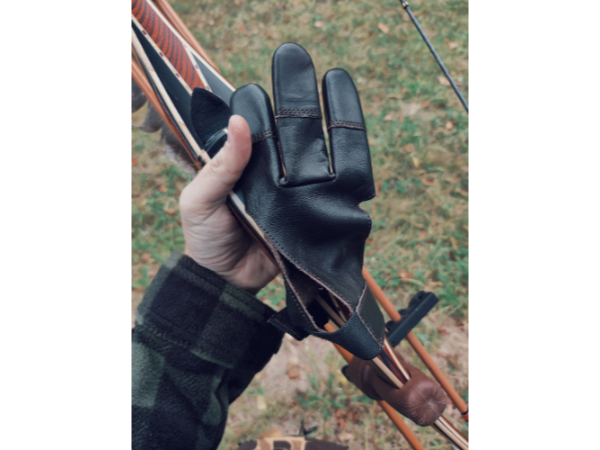Some years ago, I stumbled upon an accuracy tip that reduced my group sizes by 25%. The string I had initially purchased with my bow had a center serving that was beautifully done in an interesting checkered pattern. I was eventually disappointed when my arrow nocks began to wear through the serving. I knew it would only be a matter of time before my “best” bow string would be damaged, so I resolved to learn how to reserve the string myself.
I hied off to the local archery shop and was particularly careful to duplicate the diameter and composition of the material that had been used by the manufacturer. When I got home I dug out my antique serving tool (you know, one of those tools that seemed cool at the time but never got much use) and found the diameter of the new material would not even fit through the feed holes in the tool! While I may not be the smartest guy in town, I am persistent and refused to let the lack of a tool stop me from playing at Master Archer. That now-antique serving tool was loaded with similarly aged serving material. I figured “What the heck?” and served my string with the smaller material I had purchased all those years ago.
I was quite proud of my new center serving’s appearance, but was dismayed to find my nocks did not produce that nice clicking sound when pushed onto the string. Make no mistake, the nocks were not loose. They still produced a soft “click,” but they were not nearly as tight as they were. I found the correct location for my nock set and retired to my range. It was then I found my skill at the bow had apparently improved overnight!
I finished my practice and then fired up the computer, looking for answers to my mysteriously acquired improved skill. Why had the new serving improved the groups so dramatically? It turns out that a “standard” test for nock/string fit is to attach the arrow to the string and, while allowing the arrow to hang straight down, rotate the string. If the arrow is deflected, the string fit is too tight. If the arrow falls off of the string, the fit is too loose. The arrow should be easily dislodged by giving the string a sharp tap about six inches from the nock.
The primary concern regarding all of this nock/string fit is based on the fact that as an arrow is drawn, there is a degree of rotation imparted to the string by the archer’s fingers. When the shot is released, the “unwinding” of a string fitting too tightly to the nock imparts erratic horizontal forces to the nock end of the shaft. Another consistency issue arises as the too-tight serving gradually wears and the nock fit changes with time.
Some have found that modification to the nock throat (filing the opening larger) has produced good results. Since I have issues with the duplication of filing work, it made more sense to experiment with the serving material diameter. Fate would prove that I got lucky on the very first try, as that old serving material worked the best for me.
Once again, I find that in all things related to the pursuit of marksmanship skills, consistency is everything; and too much of a good thing–in this case tight nock fit–can sometimes be detrimental.







If you use a release does this matter?
Funny, your story is almost exactly my story this past spring.
I needed 2 new strings for my barebow target and hunting bows, so I ordered new strings last fall in anticipation of starting out fresh and tuning my bows this spring. I found my accuracy suddenly terribly erratic with the new strings – my tuning effort was getting me nowhere, and I was lucky to hit my 20 yd target at all. I realized my nocks were clicking onto the string with a little more effort than usual, but when I grabbed a nocked arrow and easily lifted the bow by the nock, I knew something was up. I sanded some nocks and that worked somewhat, and like you worried about consistency. That led me to measure the serving diameter. Turns out my string maker somehow changed the serving to a larger diameter. We went back and forth with some measurements and he agreed to make 2 new strings to a smaller dimension. What a difference! I am shooting 30 yds comfortably and hitting a 40 yd target with improving consistency.
I figured that if the string holds onto the arrow a microsecond differently each time then the dynamic spine of the arrow will change with each shot – thus you would see high-low with left-right results.
In lieu of filing the nock I took a page out of TJ’s book and dip it in a cup of hot water, then use a bread knife to spread it open a tad. Then dip in cold water to “set” it and try it on the string.
I heard about nock testing before however never with such a thorough explanation. Thanks! I’ll be testing my set up. A tighter group is always beautiful!
Having gone to fast flight on all my bows, I found typically I needed large diameter serving for good nock fit on small diameter strings. Instead of trying to get the perfect serving diameter, which is pretty hard to do with thin strings, I now serve the center serving a half inch or so and check nock fit. If fairly loose, which is typcial, I will add, say, 4 strips of string material parallel to the bowstring, anchoring with wraps of the serving. Go another half inch, and check nock fit. Eventually by adding some bowstring material I will have a good fit. Then continue the serving to about 1/2 inch from the end, discontinue the additional string material, and finish. For my setup, I generally will have 12 strands of BCY-X full length, and an extra four strands under the center cerving.
Right on!
I took an emery board nail file and wrapped some fairly fine sandpaper around it one or two or three wraps and I filed The inside of the knock from inside and halfway through I flipped it over so I should get it even filing on each side of the knock . I tested it on my bowstring periodically until I had just the right fit. This worked well. It’s not how you start, it’s how you finish. I applaud your method.
Good lesson, thanks. Learned a new word also….. Hied. Hmmm, need to use that one.
3Rivers carries a tool especially for widening nock throats.
An excellent bit of information– good to know the effects of string rotation.
Just want to echo David Sherwin’s compliment; thorough and simultaneously succinct…great bit of advice on a subject I admittedly had not considered thoroughly myself.
Thank you!